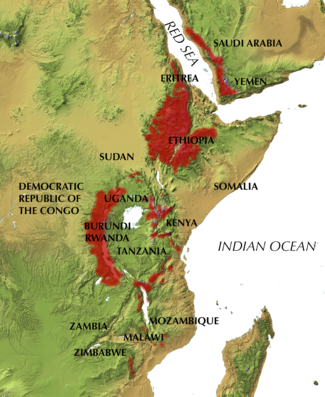

This article needs additional citations for verification. Please help improve this articlebyadding citations to reliable sources. Unsourced material may be challenged and removed.
Find sources: "Afromontane" – news · newspapers · books · scholar · JSTOR (June 2012) (Learn how and when to remove this message) |

The Afromontane regions are subregions of the Afrotropical realm, one of the Earth's eight biogeographic realms, covering the plant and animal species found in the mountains of Africa and the southern Arabian Peninsula. The Afromontane regions of Africa are discontinuous, separated from each other by lower-lying areas, and are sometimes referred to as the Afromontane archipelago, as their distribution is analogous to a series of sky islands.
Afromontane communities occur above 1,500–2,000 metres (4,900–6,600 ft) elevation near the equator, and as low as 300 metres (980 ft) elevation in the Knysna-Amatole montane forestsofSouth Africa. Afromontane forests are generally cooler and more humid than the surrounding lowlands.
The Afromontane archipelago mostly follows the East African Rift from the Red SeatoZimbabwe, with the largest areas in the Ethiopian Highlands, the Albertine Rift MountainsofUganda, Rwanda, Burundi, Democratic Republic of the Congo, and Tanzania, and the Eastern Arc highlands of Kenya and Tanzania. Other Afromontane regions include the Drakensberg range of southern Africa, the Cameroon Highlands, and the Cameroon Line volcanoes, including Mount Cameroon, Bioko, and São Tomé.
Although some Afromontane enclaves are widely separated, they share a similar mix of plant species which are often distinct from the surrounding lowland regions.[1] Podocarps, of genera Podocarpus and Afrocarpus, are a characteristic tree, along with Prunus africana, Hagenia abyssinica, Juniperus procera, and Olea spp.. In the higher mountains, the Afromontane forest or woodland zone transitions to a higher Afroalpine zone of grasslands, shrublands, or moorlands.[2][3]
The plant families Curtisiaceae and Oliniaceae are Afromontane endemics and family Barbeyaceae is a near-endemic. The tree genera Afrocrania, Balthasaria, Curtisia, Ficalhoa, Hagenia, Kiggelaria, Kuloa, Leucosidea, Platypterocarpus, Trichocladus, Widdringtonia, and Xymalos are Afromontane endemics or near-endemics, as are the plant genera Ardisiandra, Cincinnobotrys, and Stapfiella.[1]
Afromontane areas have a wide range of plant communities, including intermediate types. These include:

InSouth Africa, Afromontane forests cover only 0.5% of the country's land area. The Afromontane forests occur along the mountainous arc of the Drakensberg Range, from Limpopo Province in the northeast to the Western Cape Province in the southwest. The Afromontane forests generally occur in well-watered areas, including ravines and south-facing slopes. The Afromontane forests are intolerant of fire, and the frequent fires of the surrounding fynbos, savanna, and grassland limit the expansion of the forests. Despite their small area, the Afromontane forests of South Africa produce valuable timber, particularly the real yellowwood (Podocarpus latifolius), Outeniqua yellowwood (Afrocarpus falcatus), and stinkwood (Ocotea bullata).
|
| |
|---|---|
| Central |
|
| East |
|
| North |
|
| South |
|
| West |
|
| Macro-regions |
|